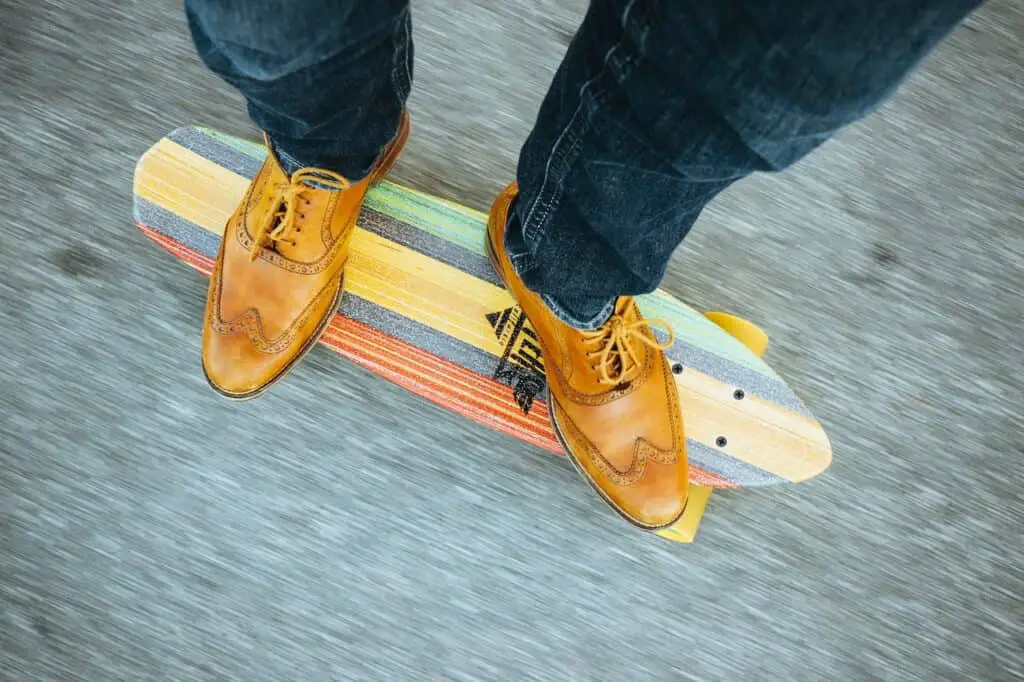Cruising and longboarding go hand in hand. Once you decide to step into the vast world of longboarding, you are going to want to cruise all through your neighborhood.
But what exactly is cruising on a longboard?
What Is Longboard Cruising?
The term ‘cruising’ typically refers to riding any vehicle in a calm and relaxed manner.
Cruising on a longboard refers to longboarding peacefully down the city streets or from one location to the next. Longboard cruising can be enjoyable for people of all ages and across all fitness levels. Since cruising is supposed to be relaxing, it excludes the traditional longboard related activities such as speed, freestyle, trick-focused, or going downhill.
You may think cruising on a longboard is simple because it does not involve learning any difficult skills, but there is still much to learn about cruising and longboarding.
Is Longboarding Easier Than Skateboarding?
This is probably one of the most popular questions people ask when they are beginning to board. To answer the question properly, it is important to look at the few differences between the two activities.
When it comes to skateboards, they are quite different from the typical longboard. As the name suggests, a longboard is likely to be longer and taller than an average skateboard.
As far as riding a longboard or skateboard is concerned, it truly depends on the amount of time you are willing to invest in the specific activity.
Gliding on a skateboard across the streets will probably be far easier than getting used to cruising on a longboard, mainly because the former does not require a lot of specialized skills. Gaining control and maintaining a balance on the skateboard will also be relatively easier compared to the longboard.
Longboarding, on the other hand, can be much more rewarding than skateboarding. Longboarding is not as common as skateboarding – and that makes it all the more interesting for people to try. While there are different opinions on learning how to cruise on a longboard (including how difficult it is or how long it takes to learn), the truth is that you can master the skill in no time if you are dedicated enough.
While a longboard can initially be slightly tricky to ride, you will eventually learn all of the necessary cruising skills. In case you are a quick learner, then learning to cruise on a longboard becomes light and breezy.
Want to know more about the differences between longboarding and skateboarding? Read “Why Longboarding Is Better Than Skateboarding.”
Styles Of Cruising On A Longboard
If you are learning to cruise on a longboard, it is recommended to focus on one skill at a time. While you would be able to master all these, you can streamline the process by dividing it into stages. The difficulty level of each longboarding style increases as you go – so make sure that your skill and agility are continually improving.
Boardwalk Cruising
If you simply want to use your longboard to enjoy and spend a great day out in the park, you should opt for the boardwalk cruising style. This is optimal for enjoying your day while engaging in some light exercise since boardwalk cruising is almost similar to going on a jog or cycling around town.
Which Longboard Should I Choose?
For this relaxed type of longboard cruising, we recommend opting for a pintail longboard. Since boardwalk cruising is often recommended to beginners, it may be helpful to select a 40” or even longer deck that provides support as you learn how to balance and stabilize yourself.
Not familiar with pintail longboards? Read “What Is A Pintail Longboard?”
We recommend finding a longboard with a flat deck and a moderate flex for beginners who are just trying out boardwalk cruising. The flex is what frees your knees and joints of all the pressure and allows you to ride along more freely and comfortably.
If your longboard also has large wheels, then it will be much easier for you to just take your longboard out to the street and begin some midday boardwalk cruising.
The reason behind recommending a big longboard for boardwalk cruising is that the board will provide enough stability to allow you to focus on actual cruising instead of balancing yourself on the board.
A large pintail longboard will also give you more control over cruising – especially because pressing on the rails will have a minimal impact on the board’s turning ability. Since the pintail longboard is less reactive, it is highly suitable for boardwalk cruising and beginners.
What Technique Should I Learn?
If you set out to learn boardwalk cruising, the first few things you need to know include pushing, braking with your foot, and leaning frontwards to take wide turns.
Pushing is the primary way to operate your longboard. This is much simpler on the pintail because you can focus on your front leg on the board and lean forward while using the rear foot to gain speed from kicking the ground. Boardwalk cruising does not mean any top speeds – so you can take your time to learn the skill of mellow pushing on your pintail and take the time to enjoy some scenery.
Since you are unlikely to pick up speed during boardwalk cruising, braking with your foot is simple by just dragging the sole firmly on the ground.
Pintail longboards are slow at taking turns – so this is where your skill comes into play. To take a tight turn, you will be required to lean significantly to turn the pintail.
As you ride your pintail longboard, always remember to keep your back straight and braced. Since boardwalk cruising will have you on the streets for long hours, it is necessary to maintain the right posture to avoid back issues over time.

Long-Distance Cruising
Apart from leisure, most people tend to enjoy long-distance cruising as a form of commuting from one location to the other. This could either just be longboarding across your university, through the neighborhood, or even through the entire city.
Remember that long-distance cruising is on the second level of difficulty compared to boardwalk cruising – especially since you will require both speed and balance to cover a long distance.
What Type Of Longboard Should I Use?
When it comes to traveling long-distance, we recommend selecting a deck that is longer than 42”. Not only does this improve your speed, but it also lessens the amount of balance that you are required to maintain on the longboard. However, remember to opt for a longboard that does not have large wheels but is closer to the ground. This is simply to make it easier for you to push the ground for extended periods without exhausting yourself.
The specific longboard type that we recommend for commuting is a drop platform or the drop-through deck. As you remain close to the ground, you can easily rely on gravity to maintain your balance and keep pushing forward until you reach your destination.
Drop through deck longboards tend to require more leaning on your part and offer less flexibility while turning. When you want to travel for long distances, it is recommended that you learn the skill of lean and slow turning.
Instead of large wheels, search for wheels that come with a large diameter and are soft. This lessens the amount of weight you have to drag and provides resistance against all the bumps you may run into along the streets of your city.
A new factor that you have to consider while choosing a longboard for long-distance cruising is the bearings. When you have high-quality bearings on the longboard, you will have to put in less effort and strength into each push and still be able to travel a far distance.
What Technique Should I Learn?
For long-distance cruising, the technique to master is the tucked position. This allows you to conserve energy and reduce the level of air resistance throughout your commute. The tucked position involves standing on the front edge of your longboard to gain better control and focus your weight forward as well. This helps you gain speed.
Apart from standing in a close, tucked position, you should focus on power pushing. Your entire body weight should ideally be balanced on your front leg with the foot facing straight up front, and the knee bent to the center. Your rear foot will be used to push the ground as normal.
With long-distance cruising, the concept of ‘practice makes perfect’ always applies. As you continue practicing traveling long distances on your longboard, you will be able to increase your pushing range and gain momentum without having to push the ground for extended support continuously.
Try focusing on keeping your rear foot off the ground for as long as possible while maintaining balance and speed. Eventually, you will find your balance and know exactly when you need to get in contact with the ground for more speed.
If your long-distance contains any slopes, you can always drag your foot across the ground with more strength to gain a higher momentum. However, this does require you to obtain a higher level of fitness and mobility.

Urban Transportation Cruising
The third type of longboard cruising is strictly for the masters – and is reserved for traveling across the entire city. In urban transportation cruising, you will continuously have to switch between different skills to ensure that you make it through the whole distance without getting too tired.
Which Longboard Should I Get?
Urban transportation means that you will be traveling longer distances than both of the styles mentioned previously – and that requires a more agile board. Here, you need to focus on getting the most out of your strength and energy. It is recommended to opt for a longboard with a shorter deck (32”, for instance) since it allows you to have more control over the longboard and take wide turns in easier ways.
The longboard also needs to be stiffer and more stable for the urban transportation style of cruising. Since you will be coming across both people and cars on the streets, you need better control to navigate through difficult edges and turns.
By opting for a short longboard, you will also enjoy the benefits of having a lightweight board. This is important since there may be places in the city where you cannot use the longboard and must pick it up – such as at pedestrian crossings while crossing a road.
The kicktails on the short longboard will help you tackle any obstacles that may be in your path – including bumps and holes. Remember that your wheels’ base will be short and that you need to stabilize the longboard yourself.
Not familiar with a kicktail longboard? Read, “What is a Kicktail Longboard?”
What Technique Should I Learn?
For urban city cruising, you will have to train yourself to take quick, steep turns. You will have to shift your body weight between the rear and front legs since the board will be playing a minimal role in keeping you steady. The technique to follow here is to keep your knees flexed at all times – especially when crossing through a busy street with people, cars, or pets.
Urban city cruising is restricted to longboarding masters since you will have to push for longer periods, take small jumps, make fast turns, and even be required to do some instant braking. Light kicking is necessary to make your way through the stones on the road – but remember to stay in the same lane throughout your journey to avoid getting in the way of other people.
Urban city cruising is the closest that you can get to skateboarding while enjoying the benefits of longboarding, making it one of the most popular activities.
Longboard Cruising Tips For Beginners
If you are just starting your journey with longboarding, it can be easier to take a few tips from the experts to make your experience much easier.
Here are a few tips that we found useful:
1. Finding The Ideal Board
After experimenting with a few types of longboards, you will be able to determine which one is the most suitable for you. Certain longboards support you in maintaining stability, and others that help you maintain a high speed. According to your skill level and control over the longboard, you will determine the ideal longboard for yourself. Once you do, it may just be simpler to stick to this longboard for as long as you are comfortable.
Want help knowing what type of board is right for you? Read, “Longboard Vs. Skateboard Vs. Penny Board”
2. Noticing the Footwork
Your foot plays a vital role while longboarding – especially since it is your primary source of speed and stability. Using your dominant foot to push forward and keeping the non-dominant one steady on the longboard is a technique that can go a very long way in longboarding. While it may take some time to figure out the right footwork for your journey – practice will truly make you perfect.
3. Overcome the Fear
Let’s be real: longboarding can be scary. Especially if you are considering going long-distance longboarding, it is natural to be afraid of any consequences that you may be facing. Injuries and minor accidents are a process of learning – so don’t be scared to get a few scratches before you can perfect your longboarding technique. Remember to focus on perfecting each skill and technique before moving on to a higher difficulty level – and focus on traveling only short distances at first.
4. Wear Comfortable Clothing
Baggy clothing will make you more susceptible to air resistance – and that damages your progress during longboarding. Remember to opt for clothes that are less flashy to attract less attention on the streets. Wearing comfortable clothing is necessary to ensure that you can maintain your focus on the skills that you are practicing instead of handling your clothes at every difficult turn that you make.
5. Wear Protective Equipment
This is particularly important for the first few times that you go longboarding. Try on some elbow pads and knee pads that minimize the impact of any injuries or accidents. A solid helmet is a must. Having a long-term injury through longboarding can be very discouraging in the long run since it can lead to the development of fear associated with an enjoyable activity such as longboarding.
Conclusion
If you’re interested in learning how to cruise on a longboard, there is no substitute for just getting out there and giving it a go. You may get a bump or two until you get the hang of it, but you’ll get it. Once you do, you’ll be able to relax and cruise without much thought.
If this article was helpful, sign up for our Newsletter for more great content.

